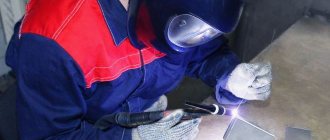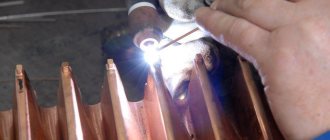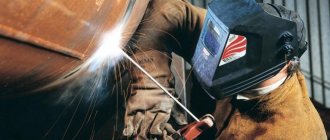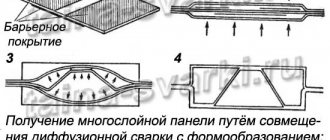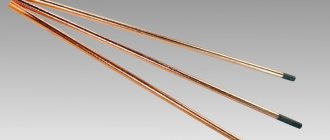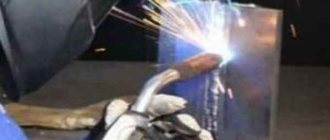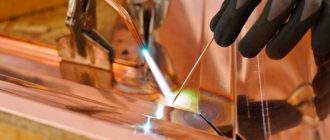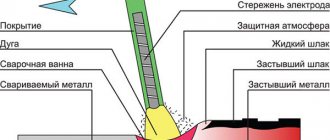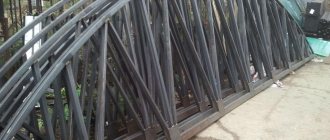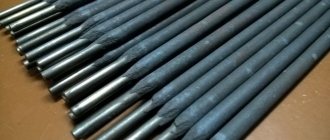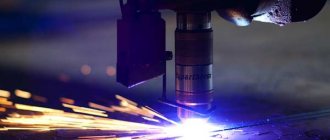Installation and repair of a copper water supply system, eliminating a leak in a car radiator - these are just some of the repair work in which the ability to weld copper and its alloys will come in handy. Welding copper at home is a rather complex process that requires experience and knowledge. Therefore, it is better to hire a professional welder to weld copper parts.
And you should not believe advertising and use various sealants and putties. Cold welding can help for a while and eliminate the leak. But work on connecting the joint will still have to be done. If you have experience working with argon and semi-automatic machines, you can easily deal with this problem yourself.
Content
- Manual arc welding of copper with metal electrodes
- Preparing the welding site
- Electrodes for welding and coatings for them
- Modes of manual arc welding of copper
- Manual copper arc welding technique
- Quality hand welded copper
- Manual welding of copper pipelines
- Manual welding with carbon and graphite electrodes
- Manual argon arc welding of copper
- Copper welding using automatic and semi-automatic submerged arc welding
- Preparing metal for welding
- Automatic Copper Welding Wire
- Fused and unfused fluxes for welding
- Automatic copper welding modes
- Copper welding technique with automatic and semi-automatic machines
- Quality of copper welding on automatic and semi-automatic machines
Copper welding has found wide application in both electronics and chemical engineering in the manufacture of devices for use in conditions where high corrosion resistance is required. Therefore, the technology of copper welding, as well as the technology of welding non-ferrous metals and alloys, in general, is constantly being improved, despite the desire to save them. Before describing how to weld copper, it is necessary to clarify that in most cases, sheet copper parts and pipes are used for welding.
We also note that there are no special types of welding for copper products. And all known methods can be used for welding them, with the exception of resistance welding, which is used to a limited extent.
Welding brass structures
Welding brass at home is a rather complicated procedure, since brass contains zinc, which evaporates when heated, as a result of which the product loses its original strength.
When carrying out welding work with brass samples, substances harmful to human health are released. With the use of argon, the procedure for joining brass is completed quite quickly - this is a major technological breakthrough in the field of metal processing.
Brass itself is an alloy with zinc. The technology for joining parts made of brass is considered difficult due to the evaporation of zinc at high temperatures; this chemical element instantly oxidizes, resulting in the formation of a toxic, refractory oxide. Therefore, welding of brass samples should be carried out in specially equipped places equipped with an exhaust hood; welders should work in respirators.
Basic requirements for welding brass
- Cleanliness of the process when using argon-arc welding. Before starting work, the products are thoroughly cleaned to a characteristic metallic shine on the surface.
- There should be no oxides on the surface of the parts being welded; if present, they must be removed. Nitric acid is used for this. After this cleaning is completed, the product is washed in hot water and then dried.
If it is necessary to join brass products with a thickness of more than 0.5 cm, argon arc welding is an ideal option. The electrode moves into the conductive zone of the torch, the edges of the metal sample being connected melt under the influence of the electric arc.
When welding parts with argon, a characteristic continuous crackling sound is felt, and the welding arc has an amazing color. This is all due to the presence of zinc in the alloy. Brass does not burn through during the joining process, nor does it fly off in separate pieces, as it melts. Experienced welders advise welding brass in separate sections and not melting it in a continuous layer. When the material melts completely, there is a possibility of burning through the metal.
If it is necessary to weld a crater, then it is recommended to gradually reduce the welding voltage, increase the length of the arc and subsequently move it away from the workpiece. In the process of such a connection, the seam is filled in full; roasting of the zinc leads to its evaporation, resulting in the formation of defects in the metal. To reduce the evaporation of this chemical element, it is necessary to increase the presence of oxygen in the flame and use filler materials alloyed with boron, aluminum, and silicon.
Advice! When connecting brass parts, carry out welding work outdoors, do not neglect safety requirements!
Manual arc welding of copper with metal electrodes
The feasibility of using consumable electrode arc welding instead of gas welding of copper is dictated by technical and economic advantages, as well as when welding steels. First of all, this method is highly productive. The speed of consumable metal arc welding is much higher than that of other welding methods. Copper arc welding can be done manually, automatically under submerged arc or under shielding gases. Copper welding using semi-automatic and automatic machines is described below in the text. Now let's look at manual arc welding of copper.
Preparing the welding site
If the thickness of the welded copper is 6-12mm, then it is recommended to perform a V-shaped groove with a total opening angle of 60-70°. If a back weld is provided on the reverse side, the angle can be reduced to 50°.
Before welding, it is necessary to move the copper sheets or strips apart at an angle to each other, with a gap of 2-2.5% of the length of the seam, see the figure on the right. If welding is carried out without first moving the sheets apart, it is recommended to pre-tack them with short seams about 30mm long at a distance of approximately 300mm from each other. Tacks are made with an electrode of smaller diameter and provide a gap between the edges of 2-4 mm. In the absence of a gap, the likelihood of overheating of the metal and the appearance of hot cracks during welding increases. When making tacks, it should be taken into account that repeated heating of copper leads to the appearance of pores in the metal, therefore, as you approach the tacks, they must be cut out and cleaned. This will not take much time, because... tacks are made to a shallow depth.
When the metal thickness is more than 12 mm, an X-shaped cutting of the edges is recommended, which will require double-sided welding. If it is not possible to perform an X-shaped cutting, then perform a V-shaped one. At the same time, the consumption of electrodes and welding time increase by almost one and a half times. In X-shaped edge preparation, the tack is made on the back side of the first seam and removed before starting the second seam.
Welding of a butt joint without edge preparation or with a V-shaped groove is performed on pads that are pressed close to the joint, or on a flux pad. Steel, copper or graphite pads with a width of 40-50mm are used with a forming groove.
Before welding, it is recommended to preheat the edges. Heating can be local, general or auxiliary, depending on the dimensions of the product and the thickness of the copper being welded. Typically the heating temperature is 300-400°C.
Electrodes for arc welding of copper and coatings for them
Coated electrodes are used for copper arc welding. The use of an electrode without a protective coating leads to oxidation of the seam, unstable arc burning and the appearance of defects in the weld seam (porosity). Electrode rods are used in the form of copper wire (which can be alloyed with silicon and manganese), bronze of the Br.KMts 3-1 brand or bronze of the Br.OF 4-03 and BR.FO 9-03 brands.
Electrode rods of this composition alloy the weld metal with silicon, manganese, phosphorus (sometimes tin) and have a deoxidizing effect. Protective coatings are selected with a composition that ensures arc stability, metal deoxidation and slag formation. All this contributes to good seam formation and improved welding quality.
More information about the brands of electrodes for welding copper products and what protective coatings are used for them in this or that case is described in detail in the article: “Electrodes for welding copper.”
Modes of manual arc welding of copper
Welding is performed with direct current of reverse polarity. The use of alternating current often does not provide the required arc stability. It is possible to weld with alternating current only if iron is present in the protective coating. In this case, it is necessary to increase the current strength by approximately 40-50%. But it should be borne in mind that the use of alternating current can lead to spattering of the electrode metal. Approximate welding modes are shown in the table below.
Modes of manual arc butt welding of copper sheets with copper electrodes using direct current:
Copper thickness, mm
| 2 | 3 | 4 | 5 | 6 | 7-8 | 9-10 | |
| Electrode diameter, mm | 2-3 | 3-4 | 4-5 | 5-6 | 5-7 | 6-7 | 6-8 |
| Current strength, A | 100-120 | 120-160 | 160-200 | 240-300 | 260-340 | 380-400 | 300-420 |
| Operating voltage, V | 25-27 | 25-27 | 25-27 | 25-27 | 26-28 | 26-28 | 28-30 |
Welding speed is 15-18 m/hour. If bronze electrodes are used, the welding speed increases, because a bronze electrode melts faster than a copper one.
When welding copper with a thickness of more than 10-12mm with an electrode diameter of 6-8mm, the welding current is increased to 500A.
When welding T-joints, the welding modes are approximately the same as for welding butt joints. In this case, it is necessary to install the welded joint “in a boat”.
Manual copper arc welding technique
Welding of large thickness copper is welded in several layers. Each previous layer is thoroughly cleaned before surfacing the next one. But it is better to weld small and medium thicknesses of copper in one pass.
Welding is performed with reverse-stepped seams, with a section length of 200-300mm. The entire length of the welded section is divided into two sections: 2/3 of the length of the seam and on the other side 1/3 of the length. First, the long section is brewed towards the small one, and then the short section. The diagram of this welding is shown in the figure on the left. This welding technique significantly reduces the risk of cracks in the metal.
Welding is performed in a lower position, or slightly inclined, and it is performed at a “forward angle”, i.e. the electrode should be tilted in the direction opposite to welding at an angle of 15-20°. When welding, “swelling” of the welded edges may occur as the gap between them decreases. In this case, the seam must be periodically corrected with a hammer or sledgehammer. It should be borne in mind that if welding is performed on a graphite backing, it may crack. Therefore, steel pads or copper pads are preferable.
Quality hand welded copper
Manual copper arc welding can provide good quality welding. In this case, forging increases the strength of the weld by approximately 10-15%, but can reduce ductility. For example, the strength of a welded joint made with copper coated electrodes “Komsomolets 100” is 200-215 MPa without forging and 230-240 MPa. Bend angle 180° without forging and 140-180° without forging.
Manual welding of copper pipelines
One of the first to perform manual welding of copper pipelines with a wall thickness of 3 mm was in the Soviet Union at the Nikolaev Shipyard. Electrodes with Komsomolets-100 coating are selected for welding. Welding is performed using direct current of reverse polarity at a welding current density of 50A/mm.
Welding is carried out with preheating to a temperature of 250-300°C. For pipelines with a diameter of up to 50 mm, complete heating is performed, and for larger diameters - local, periodic heating in sections. Before welding, tack welding is performed. The tacks must be cut out, because... welding them will lead to increased porosity in these areas due to repeated heating. The recommended maximum welding speed is 15m/hour. When welding, the base metal should not be allowed to overheat above 350°C.
Copper Welding Machine
Quality welding machines for copper:
- – semi-automatic and automatic machines;
- – TIG – devices;
- – inverters.
Popular models are produced by TESLA, SPETSELECTROMASH, ESAB.
BUDDY TIG 160 from ESAB (pictured on the right) has two and four stroke torch firing modes. It can be used to join stainless steel and most other types of metals. It is compatible with almost any generator.
RENEGADE ES 300i ESAB inverter stores several welding parameters in its memory. Automatically sets the best starting parameters based on the configured current. It is lightweight but has high power.
Inverter machines allow you to weld copper rods; they generate a current of 60-110 amperes. For them you need to buy copper/carbon electrodes. HUNTER company produces semi-professional models, for example, MMA 257D, designed for continuous operation for two hours.
TESLA is known for reliable devices such as MMA 265, 275, 255. They have a non-contact arc excitation function. They connect to a regular household network without any problems. They are convenient for welding copper and its alloys, non-ferrous metals.
For welding with electrodes
Pulse-arc welding of copper plates is possible with tungsten electrodes in an argon atmosphere using an Orion 150s or 250s . They are lightweight and allow you to weld copper efficiently and reliably. The inverter welding device Resanta SAI-220 PN can be connected to a network with a voltage of 140-220 volts. It is easy to move with, it is equipped with a forced cooling system, so it does not overheat.
For wire welding
To perform copper wire welding work, the semi-automatic inverter Energomash SA-97PA20 is used. It has a light weight of 13 kilograms. It allows you to work with wire of different thicknesses 0.6-0.9 mm.
Smooth material feeding is ensured by the Shyuan MIG/MMA-290 model at a speed of 2.5-13 meters per minute. The device makes it possible to use 1-5 kilogram cassettes and allows you to work with electrodes.
The inverter semi-automatic welding machine Soyuz SAS-97PA195 is characterized by the presence of a 60 Volt idle speed function. It has an operating voltage adjustment range of 15-23 volts. A wire of 0.8-1 mm is suitable for it. It has a light weight of 10 kilograms, it is comfortable and reliable.
Manual welding with carbon and graphite electrodes
Manual welding of copper with carbon and graphite electrodes is used to a limited extent and, mainly, for low-critical products. Let's take a brief look at its technology. It is advisable to use carbon electrodes when welding copper up to 15 mm thick. For larger thicknesses, graphite electrodes are used. Carbon and graphite electrodes are sharpened to a cone 1/3 of its length. Welding is carried out using direct current of direct polarity with a long arc. The current density at the electrode is 200-400 A/cm2.
The filler rod is not immersed in the weld pool, but is kept at a distance of 5-6 mm from it at an angle of 30° to the product. The electrode is held at an angle of 75-90° to the product. To protect the metal from oxidation, a flux consisting of 94-96% fused borax and 4-6% magnesium metal is used. Flux is applied to the filler rod, having previously moistened it in liquid glass.
If the thickness of the metal being welded exceeds 5 mm, the butt joint is welded with cutting edges with a total angle of 70-90°. The gap between the edges is 0.5mm. Welding is performed on a graphite or asbestos backing. The electrode is tilted at a forward angle 10-20° from the vertical. Metal up to 5 mm thick is forged without heating, and for larger thicknesses - with heating to 800°C and subsequent rapid cooling. Welding is recommended to be performed in one pass to ensure the best mechanical properties of the seam.
Copper water pipes
Pipes can be welded using all copper welding methods.
You can weld copper with a carbon electrode or gas welding, but the most common and not very complicated method is argon welding. According to GOST, the seam must withstand water pressure of over 10 atmospheres when testing the water supply system. The operating principle is simple. Heat the joint, drip melt from the rod and slightly stretch the metal along the seam. This is how the entire perimeter of the pipe is cooked. Gradually adding metal and stretching it, a seam bead is formed. When welding copper without stopping, you will end up with a joint with many burns and undercuts in the seam.
To perform this type of work, it is better to use a pulse type welding machine. In this case, it is possible to increase the copper welding speed and reduce the deformation of the pipeline.
To do this, set short intervals between pulses, ensuring a slight cooling of the metal. If a hole has formed in the seam, do not rush to weld it. Let the metal cool and, moving along the edge of the hole, gradually weld it.
Before starting work, you need to adjust the current strength. To do this, it is better to use old pipeline parts. This method will save expensive material.
Manual argon arc welding of copper
Manual welding of copper in an argon environment is performed with a tungsten electrode using direct current of direct polarity in high-purity argon. For welded metal with a thickness of more than 4 mm, preheating is performed to a temperature of 800°C.
As a filler material, a rod made of copper, copper-nickel alloy MNZHKT-5-1-0.2-0.02, bronze Br.KMts 3-1, Br.0Ts 4-3 is used.
If the metal thickness exceeds 6 mm, it is recommended to use a V-shaped edge groove with a total opening angle of 60-70°. Welding is usually performed from right to left, “angle forward”, the angle of inclination of the electrode is 80-90° from the vertical. The angle of inclination of the filler rod is 10-15°. The electrode extension is 5-7mm.
Material properties
To weld copper or copper-based alloys, it is necessary to perform high-quality heating of the structures. Thanks to excellent thermal conductivity, it is quite easy to ensure uniform temperature on the surface of the part and throughout the thickness of the material. However, obtaining a uniform, strong seam requires the use of certain skills.
Welding Features:
- with a significant increase in temperature, oxidation processes begin to occur in copper, as a result of which refractory phases of increased fragility are created, which negatively affects its strength and plastic properties;
- During cooling of the seam, significant shrinkage occurs, which can cause cracks;
- as a result of heating, the absorption of gases begins, increasing the likelihood of the formation of unevenness and cavities;
- welds at the junctions of copper with stainless steel and other metals have a high level of granularity associated with the heterogeneity of the materials, the connection becomes brittle and unreliable;
- due to high electrical conductivity, high currents are required on the welding machine, which makes household inverters unsuitable for welding work;
- Due to the high level of metal fluidity when heated, creating seams in a vertical or ceiling position is impossible.
Copper welding using automatic or semi-automatic submerged arc welding
When welding copper, automatic submerged arc welding is used in industry to improve weld quality and productivity. The process is carried out using automatic or semi-automatic hose machines, manually or mechanized. Welding of thin copper is successfully performed using submerged arc with a non-consumable electrode.
Preparing metal for welding
The edges need to be cleaned. Copper butt joints 6-8mm thick are assembled for welding with a gap of 1-1.5mm. For larger thicknesses, a V-shaped groove with a total opening angle of 60° is recommended. In this case, welding is performed without technological gaps.
When welding copper with a gap, the butt joint is assembled on a backing, otherwise molten metal will flow through the gap. The best results are obtained when using flux pads, but it is worth remembering that pressing the pads strongly against the metal leads to a deterioration in the formation of the weld root.
Before welding copper products, it is recommended to perform preheating. If the thickness of the metal being welded is small, you can limit yourself to local initial heating. When welding large metal thicknesses or long joint lengths, accompanying heating during the welding process is recommended. The heating temperature is 250-300°C.
Automatic Copper Welding Wire
For welding, copper wire of grades M1, M2 and M3 is used. If the wire is thin (up to 3mm), then it is pre-hardened. If it is impossible to obtain cold-worked thin copper wire, then use more elastic bronze wire of the BrOF 4-0.3, Br.Kh-1, or Br.KMts 3-1 brands. It should be noted that the use of copper wire reduces the risk of cracks in the weld.
When automatically welding copper with thin wire, it will be more technologically advanced to use machines with a wire-pulling mechanism equipped with two drawing rollers. Along with thin wire, you can use wire with a diameter of 3.4.5 mm. Wire with a diameter of more than 5 mm is not used for automatic welding of copper, because This requires special current sources.
The weld metal can be alloyed through the wire by introducing various deoxidizing agents into it - silicon, manganese, phosphorus, etc. But the best results are obtained by alloying through fluxes, especially ceramic ones.
Fused and unfused fluxes for welding
Of the fused fluxes, the most widely used fluxes are the following brands:
1. AN-348A, OSTS-45 and AN-348 - high-silicon manganese; 2. AN-51, AN-10 - low-silicon manganese; 3. AN-20 - low-silicon manganese-free.
Along with fused fluxes, ceramic ones are widely used, which make it possible to alloy the weld metal and introduce deoxidizers into its composition. The composition of ceramic fluxes K-13 and ZhM-1, used in automatic welding of copper, is indicated in the table:
| Components | Flux brand | |
| K-13 | ZhM-1 | |
| Alumina | 20 | — |
| Quartz sand | 8-10 | — |
| Magnesite | 15 | — |
| Chalk | 15 | — |
| Borax anhydrous | 20 | — |
| Fluorspar | 15-19 | 8 |
| Aluminum powder | 3-3,5 | 0,8 |
| Boron spar | — | 3,5 |
| Marble | — | 28 |
| Feldspar | — | 57,5 |
| Charcoal | — | 2,2 |
An important advantage of ceramic fluxes is the ability to weld copper using alternating current. Flux ZhM-1 is the most active and provides stable welding results. According to research by D.S. Kassov, when using it, the weld metal turns out to be cleaner in composition, see table:
| Metal | Content of components, % | |||||
| Cu | Fe | Al | Si | Mn | Others | |
| Basic | 99,76 | 0,016 | 0,008 | Footprints | — | 0,2 |
| Electrode wire M2 | 99,68 | 0,016 | 0,006 | Footprints | — | 0,3 |
| Shva | 99,92 | 0,048 | 0,004 | 0,009 | Footprints | 0,02 |
Automatic copper welding modes
In most cases, submerged arc welding of copper is performed using direct current of reverse polarity, with the exception of ZhM-1 flux, where alternating current is used.
Approximate welding modes for butt joints with submerged arcs AN-348A and OSTS-45P are shown in the table below. For large thicknesses of welded copper, fluxes AN-26 and AN-20 are used, with arc voltage U = 36-40V, and if bronze wire is used, then U = 32-36V.
Fused flux welding modes:
| Copper thickness, mm | Edge preparation | Wire grade | Wire diameter, mm | Current strength, A | Wire feed speed, m/h | Welding speed, m/h |
| 2 | No | M1,M2,M3 | 1,4 | 140-160 | 120 | 25 |
| 3 | No | M1,M2,M3 | 2 | 190-210 | 140 | 20 |
| 4 | No | M1,M2,M3 | 2 | 250-280 | 170 | 20 |
| 5 | No | M1,M2,M3 | 2 | 310-320 | 210 | 20 |
| 6 | No | M1,M2,M3 | 2 | 330-340 | 220 | 20 |
| 4 | No | M1,M2,M3 | 3 | 370-390 | 150 | 38-42 |
| 5 | No | M1,M2,M3 | 3 | 380-400 | 160 | 30-35 |
| 6 | No | M1,M2,M3 | 3 | 460-470 | 175 | 30-35 |
| 81 | V-60°, blunting | M1,M2,M3 | 3 | 360-380 | 150 | 20 |
| 82 | V-60°, blunting | M1,M2,M3 | 3 | 390-410 | 160 | 20 |
| 101 | V-60°, blunting | M1,M2,M3 | 3 | 470-490 | 200 | 20 |
| 102 | V-60°, blunting | M1,M2,M3 | 3 | 540-560 | 220 | 20 |
| 121 | V-60°, blunting | M1,M2,M3 | 3 | 510-530 | 200 | 20 |
| 122 | V-60°, blunting | M1,M2,M3 | 3 | 580-600 | 240 | 20 |
| 122 | V-60°, blunting | M1,M2,M3 | 4 | 500-510 | 120 | 20 |
| 122 | V-60°, blunting | M1,M2,M3 | 4 | 570-580 | 140 | 20 |
| 14 | V-60°, blunting | M1,M2,M3 | 4 | 530-540 | 130 | 20 |
| 12 | V-60°, blunting | M1,M2,M3 | 4 | 600-610 | 150 | 20 |
| 16 | V-60°, blunting | M1,M2,M3 | 4 | 570-580 | 140 | 20 |
| 16 | V-60°, blunting | M1,M2,M3 | 4 | 650 | 160 | 20 |
| 3 | No | Br.KMts 3-1 | 2 | 340-350 | 250 | 70-75 |
| 4 | No | Br.KMts 3-1 | 2 | 350-370 | 260 | 60-70 |
| 5 | No | Br.KMts 3-1 | 2 | 380-420 | 270 | 45-55 |
| 6 | No | Br.KMts 3-1 | 2 | 450-470 | 300 | 26-32 |
| Note. Index values: 1-first layer; 2nd layer. | ||||||
As can be seen from the table, the welding conditions for subsequent layers are more stringent than for the first layer.
Welding modes under ceramic flux ZhM-1:
| Copper thickness, mm | Wire diameter, mm | Current strength, A | Operating voltage, V | Welding speed, m/h |
| 4 | 4 5 | 490 550 | 22-24 22-24 | 42 37 |
| 6 | 4 5 | 580 640 | 26-28 26-28 | 32 28 |
| 8 | 4 5 | 650 710 | 30-32 30-32 | 26 22 |
| 10 | 4 5 | 710 780 | 34-36 34-36 | 22 18 |
Welding modes using ceramic fluxes K-13:
| Copper thickness, mm | Wire diameter, mm | Operating voltage, V | Current strength, A | Welding speed, m/h |
| 2 | 2 | 26-27 | 160-180 | 21 |
| 5-6 | 2-3 | 28-30 | 400-450 | 21 |
| 7-8 | 3 | 35-45 | 550 | 18 |
Modes for automatic submerged arc welding of copper lap joints:
| Flux brand | Sheet thickness, mm | Operating voltage, V | Current strength, A | Welding speed, m/h | Wire feed speed, m/h | Character of the current |
| AN-348A | 3 | 30-35 | 220-240 | 25 | 170 | Constant |
| AN-348A | 4,5 | 30-35 | 300-340 | 25 | 230 | Constant |
| ZhM-1 | 4 | 30 | 400-450 | 32 | 81 | Variable |
| ZhM-1 | 6 | 30 | 500-525 | 25 | 87 | Variable |
| ZhM-1 | 8 | 30 | 600-625 | 23 | 95 | Variable |
| ZhM-1 | 10 | 30 | 775-800 | 18 | 103 | Variable |
| K-13 | 6 | 30 | 400-450 | Constant |
Techniques for welding copper using automatic and semi-automatic submerged arcs
The copper welding technique is not much different from the steel welding technique. Butt joints 6-8mm thick are welded in one pass. For large thicknesses, use 2-3 passes, thoroughly cleaning each previous roller of slag before depositing the next one. Welding modes, as mentioned earlier, for subsequent layers are tougher than for the first layer.
When welding copper on semi-automatic and automatic machines, thin welding wire is used. In the case of welding butt joints, if the thickness of the metal being welded exceeds 6 mm, then a V-shaped groove is performed with a total opening angle of up to 90° with a bluntness of 3-4 mm. Welding is performed without transverse vibrations, otherwise the seam will be porous.
For semi-automatic welding of copper 10 mm thick with M2 wire with a diameter of 2 mm, single-pass welding with the following modes is recommended: current 300 A, voltage 30 V, welding speed 10 m/h. Welding is performed with transverse vibrations of the holder.
When multi-pass welding of copper of large thicknesses, in order to avoid slag inclusions, it is necessary to adhere to a certain order of deposition of the beads. After surfacing the first bead and weld root penetration, it is necessary to deposit beads on the groove sides, approximately in the same order as shown in the figure on the right.
Quality of copper welding on automatic and semi-automatic machines
The strength of the welded joint depends on the selected welding modes and the brand of flux used. The table below shows the average strength values of connections made at optimal conditions:
| Flux brand | Electrode wire grade | Mechanical strength | |||
| welded joint, MPa | weld metal, MPa | Bend angle, degrees | relative seam elongation | ||
| ZhM-1 | M2 | 177,5 | 180,4 | 180 | 41,4 |
| OSC-45 | M2 | 168,7 | 174,5 | 180 | 26,3 |
| K-13 | M1 | 258,9 | — | — | 43 (13)* |
| AN-26 | M3 | 207,9 | 203,0 | 180 | 33,8 |
| AN-348A | M1 | 192,2 | 178,5 | 180 | 41,6 |
| AN-348A | Br.KMC 3-1 | 234,4 | 307,9 | 180 | 33,0 |
| Note: Strength of the base metal 213.8 MPa *Test results for flat samples are given in parentheses | |||||
The table clearly shows that the mechanical strength of the welded joint is almost as good as the strength of the base metal.
Features for different electrodes
The progress of the welding process largely depends on the type of rods selected.
Carbon electrode welding
The technology is universal, since it is possible to ignite an arc between 2 rods, an electrode and a workpiece or mass. The process is similar to welding with a torch. To form a welded joint, BrKMts3-1 wire is used. The current and voltage are calculated taking into account the characteristics of the metal structure and alloy composition.
Inverter carbon electrode
Welding using this method can only be started if you have the appropriate skills. When performing work, take into account the following features:
- the electrode is held at an angle of no more than 30°;
- The current should be from 35 to 130 A (depending on the thickness of the workpieces).
Using a carbon electrode, you can carry out a wide range of work.
Gas welding of copper
Welding of copper sheets up to 10 mm thick is carried out with a welding flame with a power of 150 l/h per 1 mm of metal thickness. It is unacceptable to weld with a carburizing flame, because... this leads to the appearance of cracks and pores in the weld.
The weld is made in one layer. Multilayer gas welding of copper products often leads to the formation of cracks. To avoid overheating the metal during welding, it should be performed at high heating and cooling rates. We talked more about gas welding of copper on this page.
Pure borax or with the addition of other components works well as a flux. More information about fluxes for gas welding of copper is described in this article.
Welding difficulties
It is necessary to follow the recommendations of the masters, because... metal has different characteristics from other components. Main difficulties and issues arising in the process:
- Liquid fluidity complicates the connection of seams in a vertical position. In the lower position, welding is carried out using a gasket; vertical works are available in short-term mode.
- The high degree of thermal conductivity of the material will require the use of methods to remove heat from the joining area.
- Linear expansion during heating affects an increased tendency to deformation and crack formation.
You should also remember about the ability to absorb oxygen and hydrogen when exposed to high temperatures. The tendency to oxidation requires the use of special gels consisting of silicon, phosphorus or manganese.
Contact welding of copper
When welding copper, the most common type of resistance welding is butt welding. It is used for welding copper rods, wires, tapes, and pipes. But this type of welding is more suitable for welding copper alloys. Spot and seam welding are not widely used in practice. We talked in more detail about contact welding of copper products and the modes for them on the page: “Resistance welding of copper”.
A little theory
Copper and its alloy (bronze and nickel) are used in many industries due to their electrical and thermal conductivity and anti-corrosion properties. Melting point of the material is 1083°C. The thermal conductivity of pure copper is 2 times greater than that of aluminum, therefore, when welding with argon, good heating of the metal is necessary.
But the thermal conductivity of the copper alloy is already lower, which means there is no need for increased heating.
Copper and alloys are divided into several grades. To obtain a high-quality welded joint, it is better to use deoxidized or oxygen-free copper, as they contain little oxygen.
The main filler compositions for welding copper with argon are presented in the table.
But in practice, metals of similar composition are usually used (what can be found in a home workshop).
Also, for better melting and fusion of metal, rods with a thin coating of a layer of flux are used.
Preparatory activities
To weld or solder copper, you must also follow the rules for preparing the metal before welding so that the result does not disappoint you. Depending on the type of part (pipe, sheet, workpiece, etc.), it is first cut into separate parts, if necessary. Copper can be cut using a grinder, pipe cutter or machine. Plasma arc cutting is also possible. Do not use a grinder or other similar tools.
Next you need to cut the edges of the part. This is done mechanically. You also need to clean the metal and wire from oxide film and dirt, the part should literally shine. Degrease the metal. Sand the edges by hand using fine-grit sandpaper. You can also use a brush with stiff metal bristles for these purposes.
Do not use a brush or coarse sandpaper that is too hard, otherwise you will damage the metal. Also recommends etching the filler wire and the part. Etching is performed in a special solution that you can prepare yourself. The main component can be nitric, sulfuric or hydrochloric acid. The acid is mixed with water and wire blanks are placed into the solution. After etching, everything must be rinsed in water and dried with hot air.
If the part has a thickness of more than 1 centimeter, then it must first be heated in an oven or using a gas burner. Next, the parts need to be joined to each other. There should be a small gap between the parts; its size should not change when re-joined. To accurately join the parts, you can use tacks. The tacks themselves must also be cleaned to prevent cracks from forming.
Sometimes additional devices are used during the welding process. For example, graphite or copper pads, as well as removable screens. Shims are indispensable when welding bottom seams (or increase heat dissipation), and removable screens will be needed when welding copper outside (they will protect the welding area from the wind).
Radiator soldering
To solder a copper radiator you will need:
- propane tank,
- burner with reducer and hose,
- massive copper soldering iron,
- soldering acid,
- copper-phosphorus solder.
The detected leak area should be thoroughly cleaned and degreased. Next, it is heated with a torch, the surface is moistened with acid with a brush, and a little solder is picked up with a heated soldering iron. The solder is smoothed over the repair area.
A hair dryer is also used to warm up the surface..
